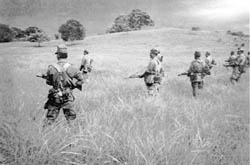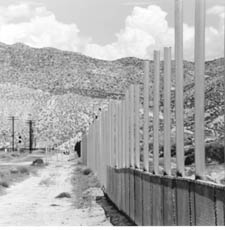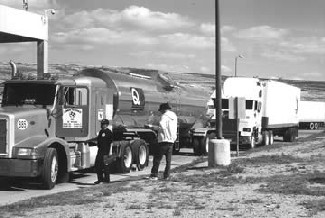Feature:
A
Perfect
Storm
on
the
US-Mexican
Border
as
Drug
and
Immigration
and
Terror
Wars
Converge
4/28/06
This week, the US Senate voted to divert nearly $2 billion dollars from the Iraq war effort and instead use the money to beef up enforcement efforts along the US-Mexican border. Driven by the explosive emergence of the immigration issue as immigrants and their supporters took to the streets in massive numbers to block a House bill that many have criticized as draconian, the move is only the latest in a long line of efforts to secure the borders.
Now, a perfect storm of bogeymen -- Drugs! Terrorists! Mexicans! -- is threatening to unleash a new wave of increased law enforcement on the border. According to border rights activists, academics, and drug reformers, increased law enforcement on the border may put a slight crimp in undocumented immigration, but won't stop the drug traffic -- and it will lead to more abuses, more violence in the desert, and a strengthening of the trend toward increased surveillance of all of us. Despite -- or because -- it consists of more than 1,700 miles of rough, remote, hostile terrain separating the First World and the Third World, the US-Mexico border is a very busy place. There a lively local cross-border traffic in "the Borderlands," that frontier area roughly 100 miles wide that encompasses both sides of the line, with Mexicans crossing daily to work and Americans to shop, dine, and get medical care, in places like San Diego-Tijuana, El Paso-Juarez, and the Lower Rio Grande Valley conurbation of Brownsville-McAllen-Matamoros-Reynosa. And the Department of Homeland Security reports detaining about one million people a year trying to get into the US without papers. The border is also a very busy place for drugs. According to the National Drug Intelligence Center, each year since 2001, US agents have seized more than 2 million pounds of Mexican marijuana (compared to the record 25,000 pounds of pot seized at the Canadian border in 2003). They also seize significant amounts of methamphetamine produced in Mexico -- more than 4,000 pounds worth in 2004. Controlled by Mexican drug trafficking organizations that emerged in the 1980s to work with Colombian traffickers but which then took over from them, heroin and cocaine also flow across the border in an unceasing torrent. Heightened border security will not stop undocumented workers from coming across, but it will ensure they pay a high price, said Pedro Rios, Project Voice coordinator for the AFSC in San Diego and a member of the Border Alliance for Human Rights. "Every time they have increased security at the border, more people end up dying as they try to cross. When people come to the US, they have no idea what the desert is like, and they are unprepared for the extreme elements," said Rios. "When they began putting up fences in the 1980s, people thought the harsh landscape would act as a natural barrier, but it hasn't stopped people from coming." Instead, they die in the desert. For the last few years, the death doll has averaged more than 300 a year, with the number exceeding 400 in 2005.
The abuses are on the increase, Rios said. "As we have seen an increase in border enforcement personnel, we have also seen an increase in human rights abuses, including those directed at US citizens and legal permanent residents. We are receiving more complaints that they are being verbally and physically maltreated. In one case, a woman with a new-born child complained that a Customs agent forced her to express milk from her breasts to prove the infant was hers. That's the kind of thing we deal with on a regular basis," Rios said. "It's getting worse." "Attempting to secure the border is ultimately futile, certainly when it comes to keeping drugs out, said Ethan Nadelmann, executive director of the Drug Policy Alliance (DPA) and coauthor of the forthcoming book "Policing the Globe: Criminalization and Crime Control in International Relations." "You can build a fence to keep people from walking over, but you can't stop them from throwing a bag full of drugs over the top. The compactness and ease of smuggling of illicit drugs is extraordinary, and if they don't come through Mexico, they will come over the water." In fact, according to the National Drug Intelligence Center, about half of all cocaine smuggled into the US comes by maritime routes, either through the Caribbean or through the Pacific off the Mexican coast. Some advocates see the immigration
and drug trafficking issues as analogous. "It is just a demonstration
of people's ignorance about what's behind migration and what's behind the
drug trade.
Unease about frontiers is nothing new, said Isaacs, but the immigration issue is taking it to a new level. "On the border, the situation is, almost by definition, one of tension, but now, there has been a mainstreaming of extremism on the immigration issue. Last year and this year, we've had the press fawning over armed vigilantes like the Minutemen taking the law into their own hands, and hard-line anti-immigration folks in Washington took that as a mandate that people are fed up and immigration is a crisis. They have upped the tension, but on the other hand, there has always been vigilante violence and abusive, excessive enforcement of the laws on the border. They think they're leading a revolution on Capitol Hill, but it's really just more of the same. The same failed policies, whether its drug policy, criminal justice policy, or border policy. In the cases of both drugs and immigration, they are going up against market forces." In the past decade, the number of Border Patrol agents has doubled and doubled again to nearly 12,000 in an effort to control the border. Similarly, state and local law enforcement agencies are taking on an increased role. Texas Gov. Rick Perry (R), for example, has shifted federal grants that formerly went to drug task forces to new border task forces. And the US military looms in the background. During the 1980s and 1990s, the US military began becoming involved in a patrolling the borders, but after an unfortunate incident in Texas, it pulled back. Chastened by the 1997 shooting death of Texas shepherd Esequiel Hernandez by a US Marine patrol looking for drug traffickers, the US military retreated, said Tim Dunn, sociology professor at Salisbury College in Maryland and author of "The Militarization of the US-Mexico Border." "The military suspended its border operations for 15 months and did an interim review, and the Department of Defense finally said it would allow ground troops, but only if an Assistant Secretary of Defense signed off on the deployment. This had the effect of really limiting the use of armed ground troops," Dunn told DRCNet. "The military was still there behind the scenes, offering assistance and training, and still quite militaristic, and of course, the National Guard, which is under the control of the states, never went away."
As for the terrorist threat, that is a canard, Dunn said. "They have never caught anyone terrorist-related coming across the Mexican border," he said. "The Border Patrol says it sees maybe a thousand people a year coming across the border from Muslim countries, and those are largely labor migrants. All of this talk about Al Qaeda learning Spanish or linking Mara Salvatrucha with Al Qaeda is utter bullshit. To call a street gang terrorism is simply absurd." Which for all intents and purposes leaves US border agencies again focused on non-military matters like the drug trade. Still, the military is back on the border. "JTF North is really busy internationally, and they don't generally have the troops to rotate down to the border," said Dunn. "But the relationship on the ground is still there, and now we are seeing troops on the ground again. Last year in southern New Mexico, they brought in a Stryker brigade with 400 soldiers and 40 light armor vehicles. They're not as heavy as tanks, but they have .50 caliber machine guns and they can hold eight or 12 troops. I never thought I would see things like this on the border," he said. The situation is increasingly tense, Dunn said. "You have the army, you have the Border Patrol, you have covert surveillance and heavily armed undercover agents, and you have these private militia groups wandering around. This is a recipe for disaster, an incident waiting to happen," he warned. Confrontations could -- and have -- taken place not only with immigrants and drug traffickers, but with elements of the Mexican military, which is under increasing pressure from the US to step up its fight against cross-border drug trafficking. "There have been shooting incidents between the Mexican Army and US agents, said Dunn, "but those are likely cases of mistaken identity. Still, these incidents add to the mix of tension and instability," he said. While Mexican President Vicente Fox has aggressively posted soldiers on and near the border, it is largely kabuki theater, said Dunn. "They post those soldiers to placate us, but they send them out in the desert without any support and they're not finding drugs because most of the drugs go through ports of entry. But no one wants to deal with that, because serious enforcement at the ports would interfere with trade." There are more workable solutions than simply trying to crack down on the border, said Dunn, also drawing an analogy between the issues. "With immigration, you have to legalize the people who are here and let them work toward legal permanent residency, and then you need a reasonable guest worker program." And trying to stop Americans from doing drugs by locking down the border is equally absurd, Dunn said. "If you want to reduce drug use, throw your money into drug education and treatment programs, and look at what other countries are doing in terms of harm reduction. We should also decriminalize marijuana, which would take a lot of pressure off Mexico and give them a real chance to do something about drug flows. Right now, the corruption there has an awful effect, and it is our demand for drugs that is responsible. We can't be any less effective than we are now, but if we take a public health approach, the border issue will become much smaller." Given the massive amount of free trade between Mexico and the US, trying to stop drugs at the border is a fool's errand, Dunn said. "As long as we have this huge volume of traffic, mixing in illegal commerce with the legal commerce cannot be avoided." The impulse toward more law enforcement on the border is ever-present and driven by the scary issue of the day. "It used to be justified by the effort to fight drugs," said Nadelmann, "then it was terrorists and national security, and now it's immigration. Cracking down on the border will make it tougher and tougher on people trying to cross, but the impact on drugs coming across will be minimal, and the porousness of the border will continue to feed increasing pressure for more internal surveillance in this country," he predicted. Nadelmann sketched a frightening Orwellian vision of a future where the totalitarian impulse toward total security moves beyond a line in the desert and into the bodies of American citizens. "As the war on drugs morphs with the war on terror and the war on illegal immigration, we will see a greater and greater push for domestic surveillance of Americans, both internal and external. We are already moving toward a national ID card, and more and more, we are relying on GPS devices, so why not have everybody wear a bracelet or a chip or a card with a biometrics and a GPS tracking device?" Nadelmann asked. "External surveillance is about tracking where you are; internal surveillance is about drug testing -- tracking what you ingest." The process is already underway, Nadelmann said. "We are already drug testing people in the criminal justice system and people who are seeking jobs. We could very easily move to having tracking devices on people, beginning with the seven million under the jurisdiction of the criminal justice system. And there would be voluntary participation, for instance, from parents afraid their children will be kidnapped or people whose loved ones suffer from Alzheimer's. Then you require it for people who want certain jobs, and eventually everyone essentially has to have an ID device with biometric drug monitoring and GPS tracking." All it would take is another dramatic attack, Nadelmann suggested. "What happens after the next major terrorist episode and the majority decides it can no longer afford to have anonymous individuals walking around free on our soil? We'll slide into this slowly, and future generations will regard constant surveillance as normal. The only obstacle to this happening is Americans' collective sense of civil liberties and freedom, but as we've seen with drug testing and now in the post-911 world, we are becoming more and more accustomed to the loss of these basic rights. The border issues will get bigger and bigger, and we will create more bureaucracies, but they will have no impact on drugs or terrorism, and the result will be intensive domestic surveillance."
| |||||||||||||||||||||||||||||||||||||||||||||||||||||||||||||||||||||||||||||||||||||



